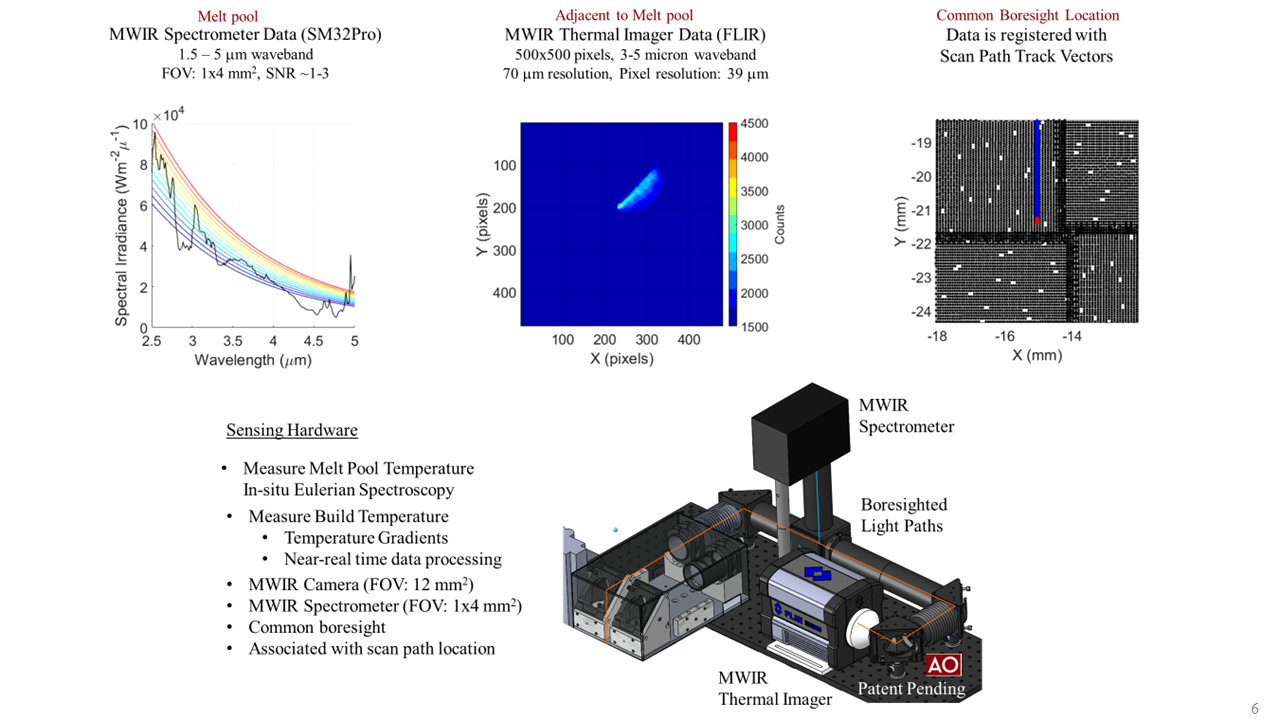


MWIR spectrometer and high-resolution thermal imager process monitoring data for melt pool thermal emission spectra and near-field temperature distribution, which was collected track-by-track and associated with scan path position.
Problem
Measurement of melt pool thermal emission spectra during Laser Powder Bed Fusion (LPBF) is highly challenging due to the small size of the melt pool, high-scan velocity, and complex scan path. The measurement is degraded or confounded by multiple transient physical phenomena (e.g., surface angle, melt pool orientation in the zig-zag scan path, laser plume), affecting the accuracy and reliability of melt pool temperature measurement. This temperature data offers valuable insight into additive manufacturing (AM) process stability, process health, and material and product quality. Attaining a successful method to measure the melt pool temperature, while compensating for the various transient phenomena, offers substantial benefit to the AM process, material, and validation of integrated computational materials engineering (ICME) models, as well as for product qualification and certification.
Objective
The objectives of this project were to demonstrate a method to measure the melt pool emission spectra routinely, accurately, and in near-real-time during LPBF processing of reactive metals (e.g., Ti-6Al-4V); compensate for transient phenomena that affected the accuracy of temperature measurement; collect measurement data track-by-track for all layers and associate with scan path position in near-real-time; and create a pathway for the utilization of melt pool thermal spectra to validate process parameter selection, process repeatability and consistency, and feedforward process control.
Technical Approach
The technical approach for this project included, the fabrication of off-axis optical hardware and algorithms to track the laser position on the build platform and provide a dynamic field of view (FOV) for in-situ sensing for high-resolution, simultaneous, mid-wave Infrared (MWIR) data collection using the spectrometer and thermal imager.
- A high-temperature mini heater was used to validate the accuracy of measurement of gray body temperature in the laboratory and in the LPBF deposition chamber.
- The team utilized the first principles of radiometry to compensate for the surface angle and curvature. They applied experimental data to characterize the effects of surface roughness and oxidation and AM process simulation to predict and compensate for gas flow.
- In order to perform characterization and compensation, the team used as-deposited and machined samples, and instrumented each sample with a thermocouple, to measure truth data.
- The team calibrated the spectrometer layer-by-layer and monitored the process to collect track-by-track MWIR spectrometer and thermal imager data to be associated with the scan path location.
- Lastly, a multispectral pyrometry algorithm was applied to process the spectrometer measurements to estimate the melt pool temperature.
Accomplishments
This project successfully collected simultaneous, high-resolution, in-situ MWIR spectrometer and thermal imager data anywhere on the build platform and validated the accuracy of measurement of gray body temperature in-situ, as well as the ability to compensate for the surface angle, roughness, and oxidation.
- The project demonstrated off-axis optical hardware to track the laser during LPBF and provide a dynamic FOV for in-situ sensing.
- There was a reduction in the spectrometer FOV close to the melt pool size using an optical field stop and mitigation of the effect of thermal radiation caused by residual heat buildup in the build.
- The project enabled the estimation of the effect of gas flow on the melt pool and spatter as a function of processing parameters using AM process simulation.
- The team identified practical modifications to the optical design to allow ~100x improved signal-to-noise ratio (SNR) for the spectrometer data and improved the melt pool temperature calculation accuracy. (The MWIR spectrometer SNR attained in the experimental work for this project was between 1 to 3, which lowered the accuracy of melt pool temperature calculation.)
Project Participants
Project Principal

Other Project Participants
- The Applied Research Laboratory at Penn State University
- 3D Systems Corporation
Public Participants
- U.S. Department of Defense
